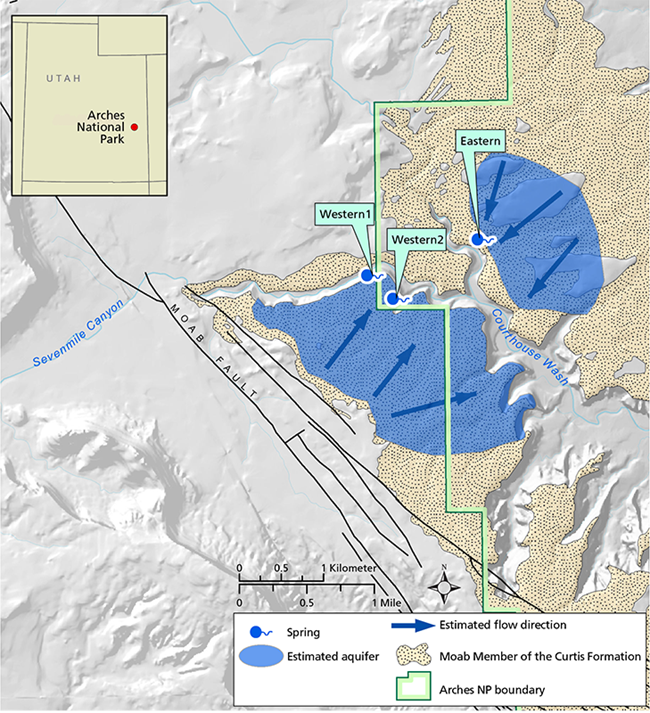Last updated: March 14, 2022
Article
Looking at the Past to See into the Future: Springflow and Climate at Arches National Park

Nearly every month for over 14 years, National Park Service (NPS) biotechnician Mary Moran packed up a stack of buckets, a shovel, and an assortment of plastic beakers. Then she hiked six miles to measure discharge (flow) at three springs in Arches National Park. Her assignment was to identify potential effects of new developments near the park boundary. But the resulting dataset revealed much more.

The springs are less than a mile from each other as the crow flies. They emerge from the same rock formation, and in the same way. Yet over those 14 years, Moran and ecologists from the Northern Colorado Plateau Network noticed that the patterns of flow were significantly different at one spring than at the other two. At two of the springs, flow declined over the years. At the other, flow remained stable. At a monthly scale, however, all of the springs showed some similar patterns.
Why might flow show different patterns at one spring over the long term but similar patterns across all three in the short term? That’s what they set out to discover.
First, they looked at local geology and land use. The two springs that behaved similarly (“Western1” and “Western2” on map) emerge on the western side of the sandstone Moab Member of the Curtis Formation. The third spring (“Eastern”) emerges on the eastern side. This sandstone layer soaks up excess water, especially in winter, and is the aquifer that feeds the springs.
However, canyons divide the aquifer into three separate areas: one each to the west, north, and east of the Moab Member. Western1 and Western2 draw their water from the western recharge area. The Eastern spring draws from the eastern recharge area.
The eastern recharge area lies entirely beneath Arches National Park. The western recharge area extends beyond park boundaries, so the scientists researched whether groundwater withdrawal might be affecting the flow of Western1 and Western2. They soon determined that this was not the cause of the disparity and decline.
Next, they turned to climate data. Climate affects springflow via two main variables: precipitation and potential evapotranspiration (PET). Precipitation puts water into the system and “recharges” springs. PET takes water out of the system. It is defined as the amount of water that would evaporate or be used by plants if water was unlimited.

Potential evapotranspiration (PET; right) is the amount of water that would evaporate or be used by plants if water was unlimited. PET increases as air temperature increases, thereby decreasing the amount of surface water available in a spring.
To determine if the long-term discharge trends were related to precipitation, the scientists compared precipitation data to discharge data. They found that in Western1 and Western2, decreases in the amount of annual average winter discharge mirrored a reduction in 10-year cumulative winter precipitation; that is, as less rain and snow fell over a number of winters, less water flowed out of the western springs. However, this pattern was not reflected in the Eastern spring.
After examining the available evidence, the scientists concluded that geological particularities probably explain why long-term flow patterns at the Eastern spring were different than those at Western1 and Western2. The aquifer that feeds the Eastern spring may hold more precipitation than the western aquifer, have a larger bedrock outcrop to capture recharge, and have greater connectivity with surrounding formations. (Picture a bathtub and a swimming pool, each with spigots coming out near the bottom. As you change how much water is flowing in or out, the water level in the bathtub will change more quickly than the water level in the swimming pool.)
Finally, they determined that the short-term similarities in flow seen at all three springs were an effect of potential evapotranspiration. PET is calculated using air temperature, day length, and how much moisture the air can hold—factors likely to have similar effects at all three springs. At a monthly scale, discharge decreased as PET increased at all three springs.
These trends in PET are a concern for park managers responsible for preserving spring ecosystems. PET is strongly related to air temperatures, and Arches National Park is getting hotter. In the years since 1901, maximum air temperatures in the warmest month, and mean temperatures of the warmest quarter, have both increased to the extremes of their historic range at Arches (Monahan and Fisichelli 2014). Further increases in air temperature are expected. Regional estimates project a 23% increase in evapotranspiration over the next 70 years (Ficklin et al. 2013). This increases the risk of drying at springs in the future as riparian vegetation uses more of the water before it hits the surface.
Why Does this Information Matter?
Given the ecological importance of water in dryland landscapes, it is essential for park managers to have continuing, site-by-site data on spring discharge. This will help them to understand what habitat is available for preserving ecosystems and species that depend on groundwater.
To maximize conservation potential, managers could consider prioritizing deeply shaded, north-facing, and/or higher-elevation springs for protection and restoration. Springs with larger aquifers may be more stable over time and have greater buffers to make it through extended drought periods without drying.
Also, in 2015, the data collected by Mary Moran and others were used to negotiate a water rights agreement with the State of Utah. The agreement includes protections for groundwater feeding into the park. The 14-year dataset, rich with information on fluctuations in spring discharge, has also been incorporated into a long-term monitoring program focusing on springs that will continue into the future. That program is operated in cooperation with scientists from the Northern Colorado Plateau Network.
The information in this brief was summarized from two more comprehensive documents:
and
